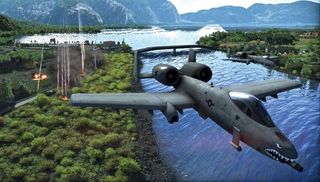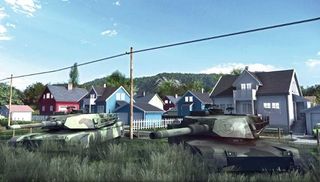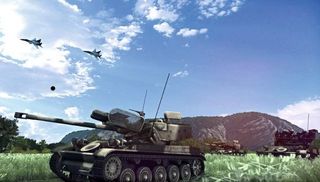Wargame: Airland Battle preview - has the Cold War ever looked so good?

I shouldn't be impressed by a game engine's zooming capabilities. It's 2013. Nonetheless, here I am staring at Wargame: AirLand Battle like a monkey at a monolith. It's breathtaking. My first look at Eugen's RTS sequel to Wargame: European Escalation, guided by lead developer Alexis Le Dressay, is of a single Apache chopper. Those familiar with the previous game's battles will know there's usually little time to appreciate details on units, but I could make out the wobble and swear I could even see the pilot. I wanted to take control, and fly it over the game's beautiful Scandinavian fields or admire the fjords. But this is not a game of sightseeing.
"At the furthest zoom it's like looking down onto a military commander's table."
As boss of one of 12 sides fighting under the umbrellas of either NATO or the Warsaw Pact countries between 1975 and '85, you're here to command troops. Luckily for the aesthetically-minded general, doing so in Eugen's world is a pleasure. A quick spin of the mousewheel yanks the camera up, parting the clouds. Below is a patchwork of fields. It looks more like a satellite photo than a game, and at the furthest zoom it's like looking down onto a military commander's table. In the game, the table would be crawling with icons of allies and enemies, and if I pushed in closer I'd see the infantry and tanks moving at frightening speed.

But the map is empty to show off the gorgeous new textures and increased scale of the game's Scandinavian setting. The square I see represents a couple of hundred of square kilometres of Swedish land, marked out with glowing strategic sectors. These sectors give you deployment points: using these lets armies bring reinforcements in. These extra units aren't built as in a standard RTS; instead, they trundle in from marked points around the world. As in the previous Wargame: EE, land units roll in from the edge of the maps, but AirLand Battle adds new air corridors, too. You'll need to have control of these before you can call in a fighter squadron, or else your enemy will simply shoot your top guns down.
"Flat fields are now surrounded with snowcapped peaks, and carved through with fjords. The undulating landscape is an immensely important addition."
These jets are the clunkily named AirLand of the title, reflecting the military doctrine of the '80s that created a greater synergy between ground and air troops. The sequel allows for greater diversity of tactics with the winged beasts, letting you send them deeper into enemy lands. They'll speedily swoop and dive at their targets, before retreating to refuel and resupply. The importance of their inclusion drove a plethora of new engine tricks that fed back into the game: the flat fields are now surrounded with snowcapped peaks, and carved through with fjords. In a game where line-of-sight usurps the unrealistic notion of fog-of-war, and your every move is preceded with recon units, the undulating landscape is an immensely important addition.
But while it's a structurally more complex sequel, AirLand Battles simplifies a few things too. The problems in the previous game's urban battles, where the infantry fighters in cities and towns needed to be looked after, have been smoothed over. The devs have solved that problem by designating 'districts' within the cities, and the infantry will always select the best possible positions to defend from.

A quick demonstration drops two tanks on either side of a garrisoned town. The tanks crawl through the fields, intelligently using the hedgerows as cover without any player prompting, but when they enter the open they're rocketed into burning piles of scrap. It's a small but welcome tweak. When Eugen's RTS gets going, there's already enough to worry about.
"What if Thatcher had a heart attack? How would that affect the UK's NATO presence in the region?"
The previous game's biggest weakness was a reliance on a standard narrative and skirmishes. AirLand Battles' campaign is now dynamic, with the whole of the Scandinavian region in continual flux, and wins and losses will affect the overall make up of the region.
The biggest gaming news, reviews and hardware deals
Keep up to date with the most important stories and the best deals, as picked by the PC Gamer team.
Weather and politics will also cause shifts in power, with special events throwing particularly cruel little twists along the way. An example that was put to me: what if Thatcher had a heart attack? How would that affect the UK's NATO presence in the region? It'd probably create a more erratic and less focussed British backup.
When you finally feel prepared enough to take your skills online, you'll have to create your own army. With 12 countries and over 700 units, you won't want for weaponry. Perhaps you desire an entirely top-hole British war unit – patriotic, what what – or an opportunity to pick and choose from the foreign legions? The units are drawn from a ten year period, so some armies will struggle in certain areas. If I were you, I'd start brushing up on your alternate history. It might come in handy.

Most Popular



